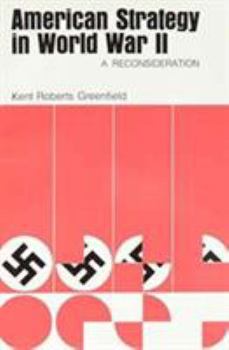American Strategy in World War II: A Reconsideration
Select Format
Select Condition 
Book Overview
Written by an eminent military historian, American Strategy in World War II explores this fascinating subject with rare perception and depth. Attention is focused on grand strategy, focused at the... This description may be from another edition of this product.
Format:Paperback
Language:English
ISBN:0898745578
ISBN13:9780898745573
Release Date:October 1982
Publisher:Krieger Publishing Company
Length:145 Pages
Weight:0.40 lbs.
Customer Reviews
1 rating
solid, compelling, concise work
Published by Thriftbooks.com User , 18 years ago
"American Strategy in World War II: A Reconsideration" by Kent Roberts Greenfield is one of the first post-war accounts of the strategic decisions made during the Second World War on the US side of the equation. As Chief of Military History of the US Army Historical Division after the war, Greenfield was a key player in the production of the 'Green Books', the official US Army history of WWII. He was therefore in a position and had access to the documents and individuals to be in a position to address questions of high strategy from the US standpoint. "American Strategy in World War II" is based on a series of lectures on the topic that Greenfield then compiled into a clear and readable prose with necessary added commentary. This is a short read (only 119 p. of formal text) that provides a good introduction to the high level strategic decisions made by the US during the war and why many of those decisions were made. Certainly this is not an ALL encompassing book and has a fair bias towards the influence of air forces ideas on overall strategy, but for such a condense book it provides a nice primer. Greenfield's book is broken into four sections: 1) 'Elements of Coalition Strategy' (pp. 3-23) - this first section deals with the basics of strategy making from the US perspective. As the title suggests, Greenfield's approach with this section is to provide the reader with a clear picture of how US decisions were made within the context of being a partner in an Allied coalition. One cannot forget that US strategy decisions were not made in isolation with no other concerns. Initially before US entry into the war most military thinking was based on hemispheric defense and isolationistic thoughts. Once it was clear that Europe and the Atlantic were threatened by the Axis powers, thoughts began to shift towards a broader defense, one that protected Britain as a bulwark of the Atlantic. At the same time the political leaders (notably, FDR) pushed for an aggressive defensive posture in the Pacific to deter Japanese aggression. Of course we now know this stance failed and was a strategic blunder. Yet US politico-military powers got their act together to develop a workable global strategy. Within this latter context was the evolving relationship with the primary allies of the US: Britain and Russia. Russia was considered a needed ally throughout the war once the US had entered and Britain seemed less likely to provide the defensive block initially assumed. The weight of US production was geared in large part to the support of one or both of these allies at different points in the war and strategy reflected the importance placed on one or both for the defense of US interests. Greenfield does a very nice job summarizing the coalition interactions and affects of these on strategy making, both from political and military perspectives. 2) American and British Strategy: How Much Did They Differ? (pp. 24-48) - this second section examines how nat





